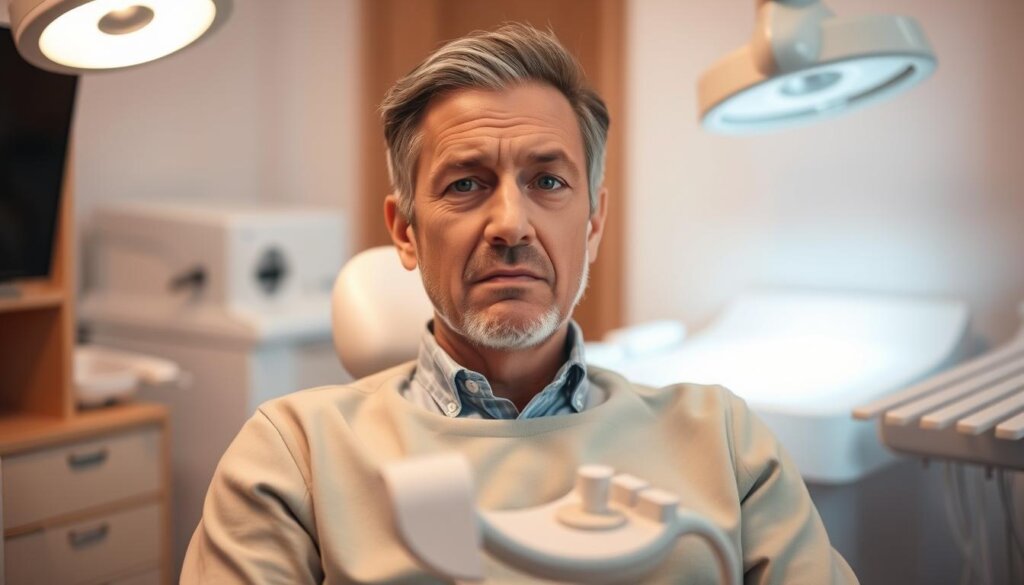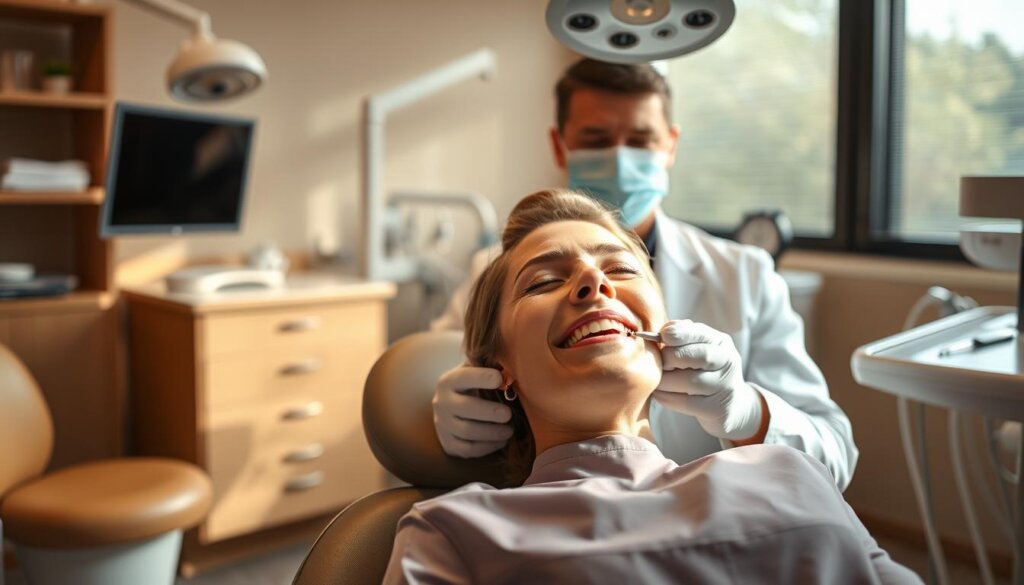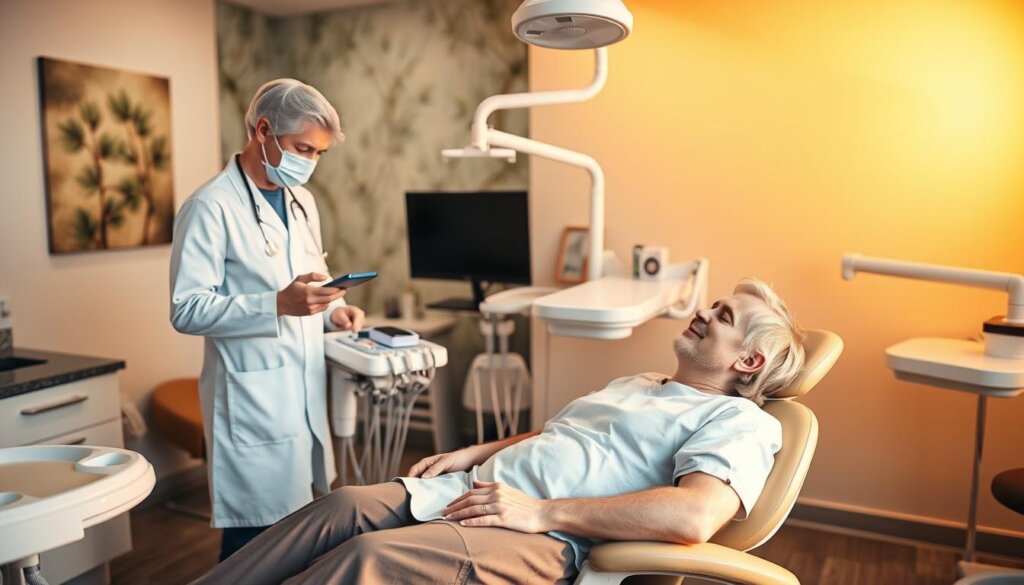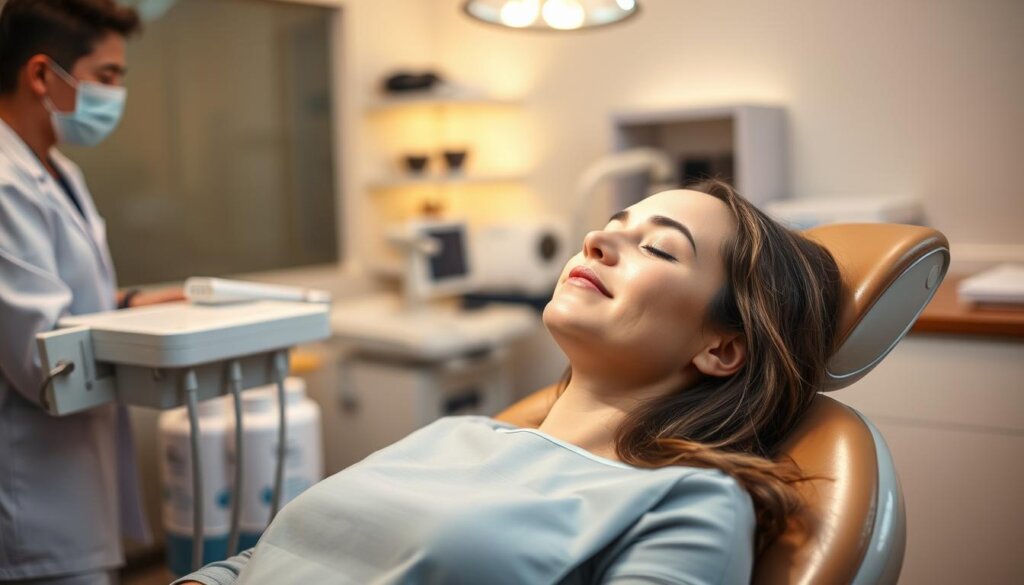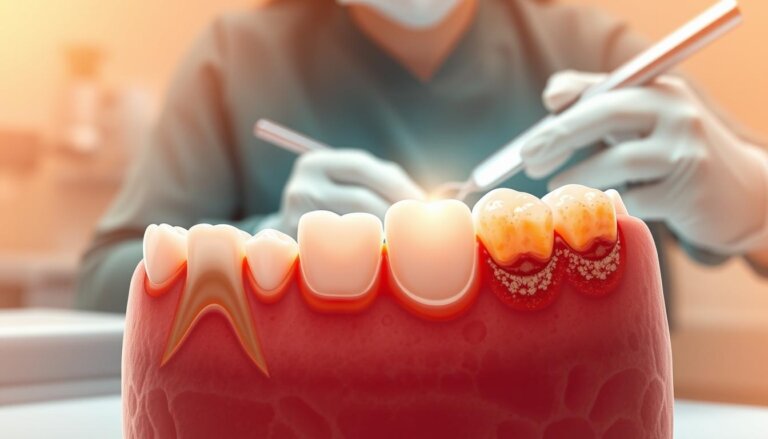Sedation for Dental Cleaning: Is it Possible?
What if the simplest path to a calm, painless cleaning has been in front of you all along—would you still avoid the chair?
Do you wonder if you can be sedated during a dental cleaning? Yes, you can. Sedation for dental cleanings is a safe method. It helps patients who fear the dentist, have a strong gag reflex, or can’t stand the closeness. Most patients who get “conscious sedation” are awake but won’t feel stressed.
Sedation is chosen to fit the person. A light sedation like nitrous oxide is typical for regular cleanings. It wears off fast, letting many drive themselves home. For deep cleanings or patients with high anxiety, doctors might suggest pills or IV sedation. This comes with careful watching. Starting sedation always involves checking your health and medications closely.
We want your visit to be easy, safe, and successful, so you keep coming back.
Key Takeaways
- Sedation for dental cleanings is possible and commonly used for anxiety, gag reflex, and sensitive teeth.
- Most care uses conscious sedation, where patients stay awake but relaxed and responsive.
- Nitrous oxide suits routine cleanings; oral or IV sedation may be used for higher anxiety or deeper gum care.
- Safety depends on medical history review, proper dosing, and continuous monitoring when indicated.
- Nitrous oxide clears fast; oral and IV sedation require an escort and recovery time.
- Dental sedation for anxious patients is tailored to the individual with clear sedation dentistry options.
Understanding Dental Anxiety
Dental anxiety is both common and misunderstood. Lots of people skip cleanings or X-rays. This is because the dentist chair, noises, or the thought of shots can be scary. Sedation dentistry helps by letting patients manage their fear and keep up with regular dental care.
Why does this matter now? Putting off dental visits can make what should be a simple appointment into a longer, more stressful one. Using dental sedation early on helps people keep regular habits and have healthier teeth and gums.
What is Dental Anxiety?
Dental anxiety means feeling really scared or stressed about going to the dentist. It can make your heart race, make you sweat, or keep you up at night. You might be scared of pain, losing control, or just not knowing what will happen.
Dental teams help by explaining things clearly, being gentle, and offering sedation to keep you calm. This makes it easier to get through visits.
Common Causes of Dental Anxiety
People get nervous at the dentist for various reasons, but the patterns are similar everywhere. Knowing why someone is scared can help dentists make visits easier and less scary.
- Fear of shots, drill noises, or vibration from cleaning.
- Feeling trapped in the chair or not liking the bright light.
- Having a very strong gag reflex or very sensitive teeth.
- Bad experiences before, like pain or not being listened to.
- Having trouble staying still because of other health issues.
Sedation can help by keeping you calm, helping you breathe steadily, and making you less aware of what’s going on.
Effects of Dental Anxiety on Oral Health
Missing dental check-ups can lead to lots of plaque, sore gums, and cavities. Not getting a cleaning can turn into gum disease, which needs more intense treatment.
Sedation dentistry stops this cycle. It helps you keep appointments, control plaque better, and stick to cleanings and care. With sedation, dental visits are easier, and your teeth stay healthier.
| Anxiety Trigger | Typical Impact on Care | Clinical Response | How Sedation Supports Patients |
|---|---|---|---|
| Fear of injections or pain | Cancelled or delayed visits | Topical anesthetics, slow injection technique | Reduces fear response; improves pain tolerance through Dental sedation for anxious patients |
| Chair-related claustrophobia | Limited time in chair; incomplete cleanings | Positioning adjustments, clear step-by-step cues | Promotes relaxation and steady breathing via Sedation dentistry for dental anxiety |
| Gag reflex or sensitivity | Difficulty with X-rays and polishing | Smaller instruments, desensitizing gels | Dampens reflexes and lowers reactivity using Sedation options for anxious dental patients |
| Past negative experiences | High stress before and during care | Trauma-informed communication, paced scheduling | Blunts memory of stimuli and improves tolerance for routine procedures |
Types of Sedation Techniques for Dental Procedures
Dental teams use a variety of sedation methods tailored to each procedure and patient. For basic dental cleanings, they aim for calmness, control, and safety. When treating anxious patients, they adjust the sedation level based on the treatment’s complexity.
Nitrous Oxide (Laughing Gas)
Nitrous oxide is breathed in through a mask or nosepiece. It starts working in about three to five minutes. The dentist adjusts the gas to ensure comfort and allow communication. When finished, oxygen is given to remove the gas quickly, letting most people drive home.
It’s great for dental cleanings because it’s gentle and safe. It’s often the first choice for patients who want relaxation without feeling tired afterwards.
Oral Sedation
Patients take oral sedation an hour before their appointment. Popular options include Halcion, Sonata, and Lorazepam; for kids, Versed syrup is used carefully. This makes patients sleepy but responsive to simple requests.
This method provides deeper relaxation than nitrous oxide. It’s used for anxious patients needing calm. They must have someone to take them home and should rest after.
IV Sedation
IV sedation offers deep, controlled relaxation. Dentists, oral surgeons, or dental anesthesiologists adjust the sedation as needed, watching vital signs closely.
Patients often remember nothing afterwards. IV sedation is used for severe anxiety or long treatments. It’s crucial for complex dental work.
General Anesthesia
General anesthesia makes the patient fully unconscious. Specialists perform it in well-equipped places with careful monitoring.
It’s used for total unawareness, but many cases are handled with lighter sedation. General anesthesia or IV sedation is only used when absolutely necessary, sometimes even for dental cleanings.
Who is a Candidate for Sedation Dentistry?
Not every patient needs medicine to relax during a dental cleaning. But many do find it helpful. Sedation dentistry helps those with dental anxiety feel comfy, especially if fear or health issues make sitting through care tough. Our team checks your health and needs. Then, we choose the right sedation for your dental work and health.
The aim is a calm, cooperative visit with stable vital signs and predictable recovery.
Age and Health Considerations
Who can get sedation depends on their age, what medicines they take, and their health. Some children might get a safe dose of a liquid sedation if they’re very scared. Most teens and adults do well with laughing gas or pills that relax you and make you less aware.
People with asthma, sleep problems, or heart issues need special care plans and watching. Yet, with the right doctor’s OK and adjusting the dose, sedation is still an option. IV sedation requires someone skilled to watch your oxygen and blood pressure closely.
- Medical review: history, allergies, and current prescriptions
- Airway assessment: Mallampati score and nasal patency
- Vital sign stability: baseline blood pressure and oxygen saturation
History of Anxiety or Phobias
Severe fear of dental work, fear of needles, or fear of small spaces can make even a simple cleaning hard. Also, if you have a strong gag reflex or very sensitive teeth, you might feel more anxious. Sedation helps lower the worry before your dental visit and helps stop panic triggers while you’re there.
If you get very worried before dental visits or wait to go until it hurts, sedation plus breathing techniques can help. It can make the dental visit seem not so scary, making you less afraid next time.
Previous Experiences with Dental Visits
If you’ve stopped a dental procedure before, had trouble with cleaning tools, or left before it was done, sedation might be a good choice. When you need a deep cleaning because of gum disease, sedation can make it easier to stay still. This means the dentist can clean your teeth better in less time.
If past dental visits were tough, like painful shots or being in the chair too long, planning ahead can help. Sedation and things like numbing creams, special numbing shots, and quiet drills can make your visit smoother.
| Candidate Profile | Clinical Clues | Recommended Approach | Monitoring Needs |
|---|---|---|---|
| Healthy adult with mild anxiety | Racing heart before cleaning; tense jaw | Nitrous oxide or low-dose oral benzodiazepine | Standard vitals at intervals |
| Child with behavior challenges | Inability to sit still; tearful on entry | Behavior guidance plus liquid midazolam when indicated | Continuous observation and pulse oximetry |
| Strong gag reflex or sensitive teeth | Gagging with radiographs; pain to air/water | Nitrous oxide with desensitizing agents and topical anesthesia | Routine monitoring with readiness to pause |
| History of traumatic dental care | Appointment avoidance; prior incomplete cleanings | Oral or IV moderate sedation with staged care plan | Continuous blood pressure, ECG as indicated, pulse oximetry |
| Cardiopulmonary comorbidity | Hypertension, sleep apnea, or COPD | Medical clearance; conservative dosing and airway strategy | Enhanced monitoring and recovery oversight |
The Benefits of Sedation during Dental Cleaning
Sedation helps people feel at ease during dental cleanings. It makes appointments seem shorter. This encourages regular visits for better health.
Reduced Anxiety and Stress
Many fear dental tools, escalating their stress. Sedation helps by quieting this fear, making future visits less worrying.
It lowers anxiety, prompting people to keep up with their dental checkups. This leads to a more relaxed experience and consistent care.
Enhanced Comfort During Procedures
Sedation eases the discomfort of dental cleanings. It makes it easier for the dentist to work, keeping patients comfortable.
It makes cleaning and maintenance more bearable. Also, it assists in managing pain, ensuring treatments are effective without added stress.
Improved Cooperation with the Dentist
Staying still is crucial for effective cleanings. Sedation aids in following directions and staying put, enhancing the work’s efficiency.
For intensive cleanings, it ensures smooth cooperation. This allows more to be done in less time, safely and well.
Consultation: Discussing Your Dental Anxiety
When you meet the dentist, they want to know what makes you nervous. They’ll ask, “Can I be sedated for a dental cleaning if I’m anxious?” This question helps them make a detailed plan. They explain how sedation can be adjusted for simple cleanings or more complex treatments.
How to Communicate Your Concerns
Talk about what scares you like needles, dental tools sounds, or feeling stuck. Mention your past dental visits, what helped, and what didn’t. Also, tell them if you have trouble moving or any special needs.
Be clear about what you want. A stress-free cleaning or to forget the visit? If you’re thinking about sedation for your anxiety, mention it early on. This will steer the dentist’s advice on sedation options.
What to Expect During the Consultation
The dentist will look at your health history and talk about allergies and any illnesses that affect sedation. They describe different sedation types: laughing gas for quick ease, oral sedation for deeper calm, IV sedation you can adjust, and full anesthesia for special cases.
You’ll hear about how you’ll feel—mostly relaxed, maybe sleepy, and possibly forgetful. They’ll explain how they keep an eye on you, especially if you get IV sedation. And they’ll cover the recovery process, including not driving after certain sedations but getting back to normal quickly with others. This helps answer if sedation is okay for your dental cleaning and shows how it’s a safe choice.
Questions to Ask Your Dentist
- Which options fit a routine cleaning versus a deep cleaning under local anesthesia?
- Who administers and monitors the sedation—your dentist, a CRNA, or a board-certified dental anesthesiologist?
- What credentials, permits, and emergency training support the service in this practice?
- How is dosage chosen and adjusted for weight, age, and medical conditions?
- What side effects should I expect, and how often do they occur with each method?
- What logistics apply—fasting rules, medication timing, and the need for an adult escort after oral or IV care?
Tip: Bring a current medication list and a concise health summary. If Sedation dentistry for dental anxiety is under consideration, confirm how the team will coordinate monitoring, recovery time, and after-visit instructions.
| Topic | What You Share | What the Clinician Explains | Why It Matters |
|---|---|---|---|
| Triggers & Prior Experiences | Noises, needles, gag reflex, chair claustrophobia; past coping methods | Tailored desensitization and sedation choices | Aligns care with comfort needs |
| Medical History & Medications | Conditions, prescriptions, allergies, supplements | Risk assessment and drug interactions | Improves safety and dosing accuracy |
| Sedation Levels | Preference for alertness vs. deeper calm | Nitrous, oral, IV, and rare use of general anesthesia | Matches intensity to procedure complexity |
| Monitoring & Recovery | Availability of escort and time off | Vital sign monitoring, driving limits, expected drowsiness | Ensures safe discharge and follow-up |
| Procedure Scope | Routine cleaning vs. deep cleaning needs | When sedation is appropriate for each | Sets realistic expectations and outcomes |
Sedation Dentistry in the United States
In the US, dentistry offers various sedation methods to fit each procedure and comfort level. These methods meet safety standards. They help patients get care without fear.
What does access look like in daily practice? For simple cleanings, nitrous oxide is a go-to. Deeper sedation depends on the dentist’s skills and the clinic’s setup. This range allows for both regular check-ups and complex surgeries.
Popular Practices Offering Sedation Services
General dentists often use nitrous oxide and pills to ease patients. This helps with cleanings and repairs. Periodontists use IV sedation for surgeries, watching patients closely.
Oral surgeons offer IV sedation and general anesthesia in certified places. Dental anesthesiologists work with clinics to tackle tough cases and long treatments.
- General dentistry: nitrous oxide, oral sedation for cleanings and fillings
- Periodontics: IV sedation for grafts, scaling, and surgical care
- Oral surgery: IV sedation and general anesthesia for extractions and implants
Regulations Surrounding Sedation Dentistry
To use oral and IV sedation, states ask for special training and emergency plans. Dentists must track vital signs and plan for safe recovery.
Only trained teams can give general anesthesia. This makes sedation safe and effective for all types of dental visits.
- Permit level matches sedation depth and provider training
- Equipment and drugs for rescue must be present and current
- Recovery criteria guide discharge after moderate or deeper sedation
State Variability in Sedation Options
Sedation availability varies by state due to different rules. Nitrous oxide is easier to find for basic cleanings. More intense sedation relies on local laws and dentist qualifications.
There’s a difference between urban and rural clinics in what they offer. Checking a dentist’s qualifications and their emergency measures is key. It ensures the sedation plan fits the patient’s needs and is safe.
| Setting | Common Modalities | Typical Monitoring | Usual Indications |
|---|---|---|---|
| General Dentistry | Nitrous oxide, oral sedation | Vital signs, pulse oximetry | Cleanings, fillings, simple crowns |
| Periodontics | Oral sedation, IV sedation | Continuous pulse oximetry, blood pressure | Scaling under sedation, grafts, surgical therapy |
| Oral & Maxillofacial Surgery | IV sedation, general anesthesia | ECG as indicated, capnography, full recovery checks | Extractions, implants, complex procedures |
| Mobile/Visiting Anesthesia | IV sedation tailored to case | Capnography, advanced airway readiness | Long visits, high anxiety, medically complex patients |
Preparing for Your Sedation Appointment
Getting ready for sedation at the dentist means planning ahead. Our team values open talk, easy checklists, and help from family or friends. It’s important to tailor your prep to the type of sedation you’ll have.
Pre-Appointment Instructions
Tell us all about your health, such as any allergies, conditions of the heart or lungs, sleep issues, and every medicine or supplement you’re taking. If your meds might change, bring notes from your doctor.
If you’re taking a pill for sedation, swallow it about an hour before you come in. Eat something light unless we say not to. Stay away from alcohol and weed for a day.
With IV sedation, there are strict rules about eating beforehand. You might need to limit water too. Check with us about pausing meds like blood thinners or benzodiazepines, but don’t change anything without asking.
Nitrous oxide is easy to get ready for. Eating a little can help avoid feeling sick. Brushing your teeth makes the process more comfy.
What to Bring to Your Appointment
- A list of what medications you’re on, their doses, and when you take them; include non-prescription drugs and herbal stuff.
- Info on any health issues you have and any recent tests or scans that matter.
- The directions we gave you and any questions about getting back to normal afterwards.
- Someone over 18 to take you back home if you’re getting oral or IV sedation; using a ride-share is okay if a friend or family member is with you.
Little things can make dental sedation easier. Think about bringing chapstick, a comfy sweatshirt, and noise-blocking headphones if we allow it.
Arranging for Aftercare
People who get nitrous oxide usually snap back fast and can drive if the dentist says it’s okay. But, after oral or IV sedation, you might feel sleepy all day. So, no driving, signing important papers, or using heavy machines.
- Plan for a quiet night. Drink plenty of water, eat soft food, and take any painkillers we suggest.
- Make sure your home is ready for your recovery: stack up some pillows, have a thermometer handy, and keep some gauze nearby if you’re getting a deep cleaning.
- If you’re getting treatment for gum disease, you might feel a bit tender. A toothpaste for sensitive teeth can help, and do saltwater rinses if we recommend it.
- Have someone check on you by phone for the first few hours and stick to any follow-up appointments we set up.
Good aftercare makes sedation for dental work smoother and helps patients feel safe from start to finish.
Safety Considerations with Sedation
For safe care, we need licensed experts, right tools, and clear rules. Sedation dentistry helps people with dental fear in a predictable way. This happens by following special standards for checking patients, giving doses, and watching over them. What does this process look like, and how do the methods for calming nervous dental patients vary?
Potential Risks and Side Effects
Most folks only feel mild side effects that go away fast. Feeling sleepy or foggy is typical with pills or IV sedation. Some might not remember the procedure on purpose to ease stress. Nitrous oxide (laughing gas) wears off quickly when followed by oxygen.
Less common issues like nausea, low blood pressure, or unexpected restlessness are handled with specific steps. Checking medical records and past meds helps pick the right sedation method. This reduces risks in sedation dentistry for those afraid of dental visits.
Monitoring During the Procedure
Watching patients closely is key for safety. The team keeps an eye on vital signs like heart rate and breathing. With IV sedation, the amount of medicine is adjusted based on the patient’s needs. Laughing gas levels can be changed easily, keeping relaxation light and steady.
Pill sedation needs careful dose planning and close monitoring, as timing can vary. For all types, trained professionals keep track of health signs, breathing, and alertness. This keeps sedation dentistry safe and under control.
Recovery and Aftercare Tips
The steps to recover depend on the sedation method. People using laughing gas wake up quickly and can usually drive themselves. But those who had pill or IV sedation should not be alone, rest at home, and skip hard tasks for the day.
- Drink water and follow the dentist’s instructions.
- Stick to simple foods unless your dentist says otherwise.
- Only use painkillers approved by your dentist.
- Call the dental office if you feel very dizzy, keep throwing up, or have trouble breathing.
Good advice helps tailor sedation choices to each patient, ensuring safety. When followed, these directions mix comfort with precision in dental care.
| Sedation Method | Typical Onset | Common Side Effects | Monitoring Focus | Discharge Guidance |
|---|---|---|---|---|
| Nitrous Oxide | Minutes | Light dizziness, tingling | Oxygen saturation, comfort level | Usually alert on exit; many can drive |
| Oral Sedation | 30–60 minutes | Drowsiness, grogginess, possible amnesia | Airway, blood pressure, responsiveness | Escort required; rest for the day |
| IV Sedation | Within minutes | Deeper relaxation, possible amnesia | Continuous vitals, titration of dose | Escort required; avoid complex tasks |
Cost of Sedation for Dental Cleanings
Figuring out the cost of Sedation for dental cleanings means understanding how the procedure works. It also means knowing about the time spent in the chair and the level of care needed. Dental offices think about patient safety, how they will watch over the patient, and the type of care needed. They explain the cost of Sedation dentistry during the consultation to avoid any surprises.
Factors Influencing the Cost
The cost changes depending on the method and time used. Nitrous oxide is usually cheaper because it’s quick and easy to monitor. Oral sedation costs a bit more because it needs careful prescription management and a longer watch period. IV sedation is the most expensive due to the need for special staff, equipment, and more time to keep an eye on the patient.
What the procedure involves also impacts the price. Simple cleanings might need less support. But deeper cleanings, like scaling and root planing, require more intensive methods and longer appointments. Where the clinic is, the dentist’s training, and if an anesthesia provider is there also play a part in setting the cost.
- Technique and duration: More time and oversight increase fees.
- Clinical complexity: Deep gum cleaning elevates resource needs.
- Team and equipment: Monitors, oxygen delivery, and IV supplies add cost.
- Geography: Major metro areas often show higher operating expenses.
Insurance Coverage for Sedation Dentistry
Insurance coverage for Sedation during dental cleanings varies. It depends on the insurance plan and if the Sedation is medically needed. Mild sedation isn’t usually covered unless there’s a strong reason for it. If a patient has severe anxiety, special needs, or needs a lot of dental work, insurance might cover part of the cost.
Getting preapproval can clear up which Sedation dentistry costs are covered. It’s also important to check if your insurance sees sedation as a dental or medical benefit. Plus, you should find out if the insurance’s network rules will impact your coverage.
- Request a written estimate with procedure and sedation codes.
- Submit records that document anxiety, medical needs, or planned complexity.
- Confirm any limits on duration, modality, or provider qualifications.
Budgeting for Sedation Options
When budgeting, consider the cost of Sedation, the dental work, and any exams. For oral or IV Sedation, remember the cost of someone to take you home and possibly taking time off work. Health savings accounts and flexible spending accounts can help with these costs.
To avoid surprises, ask for a detailed quote that includes all Sedation dentistry costs. Many dental offices have payment plans to spread out the cost. This helps match the care to both your comfort and budget needs.
Alternatives to Sedation for Dental Anxiety
Many patients look for comfort without using medications. They sometimes mix light drugs with behavioral strategies. Our method combines learning, concrete steps, and giving patients control.
This supports a calm and consistent experience.
Relaxation Techniques
Slow breathing helps control your heart rate and reduces stress. Try this technique: inhale through your nose for four seconds, pause, then exhale for six seconds. Do this for two minutes before starting your dental cleaning.
Guided relaxation helps ease muscle tension. Checking in with your body—focusing on the jaw, shoulders, and hands—can lessen tightness and make things more comfortable. These methods can also enhance the effect of nitrous oxide.
Stress-Reduction Strategies
Knowing what to expect can lessen worry. Talking with your dentist before the visit about what will happen helps you feel prepared. Many dental offices offer this chat as part of their service.
Starting with easy visits builds up your confidence. Begin with an exam and polish, then add more steps later. A simple hand raise lets you pause the procedure anytime, making you feel safer.
Distraction Methods During Treatment
Noise can make some patients anxious. Wearing headphones that block out sound can help. They can listen to music or an audiobook. This helps keep their mind off the dental work.
Looking at something calming, like art on the ceiling or a timer on a smartwatch, can also distract you. Along with reminders to breathe or relax your shoulders, these tools help keep you calm. They work well alongside sedation.
- Tip: Plan short breaks every five minutes to check how you’re feeling.
- Consider using a weighted blanket or warm neck wrap for extra comfort.
- Ask if the ultrasonic scaler can be adjusted for your comfort level.
These strategies are designed with the help of your dental team. They tailor these practices to fit your needs, offering care that respects your independence while addressing dental anxiety.
Post-Procedure Care After Sedation
Recovery after sedation for dental cleanings is usually smooth and straightforward. Our aim is to ease the experience for those feeling anxious, while prioritizing safety. These tips are meant to help patients and their dental team have the same expectations and promote a speedy recovery.
What to Expect After Your Cleaning
Using nitrous oxide means you’ll recover quickly. A short burst of oxygen will help clear your system. You’ll feel back to normal in no time, allowing you to continue with your day.
Oral or IV sedatives take longer to wear off. You might feel sleepy, less sharp, and a bit slow. It’s important to relax for the day, steer clear of driving, and delay any big decisions.
If your treatment included a deep clean for gum disease, your gums might feel tender and sensitive. This happens as plaque and tartar are cleaned out. Using cool water, a gentle toothbrush, and saltwater rinses can provide relief.
When to Contact Your Dentist
- Persistent dizziness or confusion that doesn’t get better with rest.
- Bleeding that doesn’t stop when you press on it gently.
- Pain that your meds can’t handle.
- A fever, swelling in your face, or a nasty taste that could mean infection.
Good communication is key after being sedated for dental work. Keep your aftercare instructions handy, and don’t hesitate to reach out to your dental office if something doesn’t feel right or gets worse.
Tips for Pain Management
- Take over-the-counter pain meds as your dental team advises. Switching between acetaminophen and ibuprofen can help when it’s okayed.
- Be gentle with your teeth and gums. Use a soft toothbrush and floss carefully to help the healing process.
- Stick to lukewarm food and drinks at first. Avoid anything too hot, too hard, or too spicy to keep from irritating your mouth.
- Rinsing with warm saltwater a few times a day can soothe sore spots.
- Make sure you follow through with any special rinses or toothpaste your dentist recommends.
These steps are designed to go hand-in-hand with sedation for those who are nervous, helping reduce stress and increase comfort. Good care after sedation is crucial for healthy gums and helps with long-term care.
| Aspect | Nitrous Oxide | Oral Sedation | IV Sedation | What Patients Should Do |
|---|---|---|---|---|
| Alertness After Visit | Rapid return to normal | Mild to moderate drowsiness | Moderate drowsiness | Plan rest if drowsy; avoid driving |
| Common Sensations | Lightness, calm | Grogginess, dry mouth | Sleepiness, reduced recall | Hydrate, eat soft foods as tolerated |
| Gum Response After Deep Cleaning | Mild sensitivity | Tenderness, sensitivity | Tenderness, sensitivity | Use soft brush, saltwater rinses |
| Pain Control | Often minimal | OTC analgesics as directed | OTC analgesics as directed | Follow dosing schedule precisely |
| Red-Flag Symptoms | Unusual dizziness | Uncontrolled pain, bleeding | Persistent confusion, swelling | Contact dentist if any red flags occur |
| Best For | Quick recovery needs | Heightened anxiety | Complex care with anxiety | Match sedation level to procedure and history |
Success Stories: Overcoming Dental Anxiety
Clinical teams across the U.S. are seeing progress when they use Sedation for anxious dental patients. Whether it’s a simple cleaning or a more involved treatment, Sedation helps patients relax, cooperate, and keep their appointments. When fear is lessened, appointments go smoother, and preventive care is easier to maintain.
Real-Life Experiences of Sedation Dentistry
Patients who delayed dental care now find a new level of comfort. They stay alert but without the panic, as their fear gently fades away. Many hardly remember the procedure later, easing anxiety for future visits.
Clinicians point out that Sedation makes dental care easier by relaxing the patient. This leads to better cleaning, less discomfort, and fewer stops during the procedure.
Testimonials from Satisfied Patients
“I used to cancel every six months. With light oral sedation, I felt relaxed, and the cleaning seemed shorter. Now I book my next visit before I leave.”
“Nitrous oxide took the edge off. I stayed awake, but the scraping no longer made me panic. I left feeling proud instead of drained.”
“For deep gum cleaning, IV sedation kept me comfortable. I remember being reassured, then it was done. I’m no longer avoiding care.”
These stories share a theme: Sedation turns fear into a manageable concern. This helps patients follow through with their dental care.
The Impact on Long-Term Dental Care
When dental visits seem easier, people keep coming back. This consistency leads to healthier gums and fewer emergencies. Over time, trust grows, patients can handle longer treatments, and they keep up with their dental hygiene at home.
| Outcome | Patient Experience Shift | Clinical Effect | Relevant Sedation Approach |
|---|---|---|---|
| Reduced anticipatory fear | Calmer night before visits | On-time arrivals, fewer cancellations | Nitrous oxide for fast onset and quick recovery |
| Improved procedure tolerance | Less sensitivity to sound and scraping | More complete plaque and calculus removal | Oral sedation for mild to moderate anxiety |
| Enhanced cooperation | Stable breathing and steady posture | Shorter chair time, smoother instrumentation | IV sedation for severe anxiety or complex cleanings |
| Sustained preventive care | Confidence to schedule routine follow-ups | Better periodontal maintenance and stability | Customized plan using Sedation dentistry for dental anxiety |
When anxiety eases, everyone works better together. With the right Sedation strategies, taking care of your teeth becomes easier and more doable.
Finding a Dentist Skilled in Sedation
Looking for a dentist starts with knowing what you want. You should pick sedation dentistry that fits your needs. This could be for regular cleanings or more complex treatments. We offer advice on choosing the right sedation option for those who feel nervous, ensuring safety and good communication.
Researching Local Practices
Start by finding dentists nearby who offer sedation for regular visits. Look for places that use laughing gas for cleanings, have clear plans for pill-based sedation, and offer sedation through an IV with experts on hand.
Check if they change the sedation amount based on your health and how long the treatment is. Good clinics will tell you how they keep an eye on you during and after the procedure. This shows they care for their patients and are clear about the process.
Importance of Credentials and Training
Training is key. Make sure the dentist is allowed to provide the level of sedation you need. They should also be trained in life-saving techniques, especially for IV sedation, and know how to keep your airway open.
Good practices keep a close watch on your vital signs during sedation. They check your oxygen levels, heartbeat, and breathing. This approach shows they’re serious about your safety and comfort.
Reading Reviews and Patient Feedback
What other patients say is important, too. Positive reviews about calm visits, clear instructions, and smooth recovery matter. Pay attention to comments about prompt follow-up calls, careful adjustment of sedation, and clear costs.
If many people talk about a dentist’s kindness, easy-to-understand info, and careful monitoring, it’s a good sign. Trust grows when happy patients’ stories match the clinic’s safety standards. This makes you feel better about their sedation options.
The Future of Sedation Dentistry
Sedation is now more common in dental care. Clinics now offer many Sedation dentistry options. They fit the patient’s needs and how nervous they are. This helps people get regular cleanings and safe gum treatments, even if they’re scared.
Why does this matter now? Anxiety stops millions from getting dental care. Practices are using better drugs with close monitoring. They aim to calm patients, keep vital signs stable, and ensure safe results.
Innovations in Sedation Techniques
There are new drugs, dosing methods, and support systems. Better uses of benzodiazepines and other drugs help control how quickly patients feel effects and recover. Devices that monitor breathing and heart rate keep patients safe during treatments.
- Refined titration: Smaller IV doses and doses based on weight reduce the risk of too much sedation.
- Enhanced monitoring: Advanced equipment for checking breathing and heart health improves safety.
- Behavioral pairing: Techniques like guided breathing help reduce the need for drugs.
Rising Acceptance of Sedation for Routine Care
Now, patients can choose from different types of sedation. Dentists and hygienists work together to help everyone keep their teeth clean. This is great for people who are very sensitive or have had bad experiences before.
- Access: Many clinics now clearly explain their Sedation dentistry options.
- Efficiency: The process is faster, so patients spend less time in the chair without lowering care quality.
- Equity: Clinics focus on helping anxious patients to stop dental problems from getting worse.
Ongoing Research and Development
Experts are studying the best ways to use sedation safely. They look at patient comfort and how well treatments work. They’re also checking how new monitoring tools can help patients after their visit.
Current priorities include:
- Figuring out the lowest effective dose for people with other health issues.
- Making sure patients are really ready to go home after sedation.
- Checking if people keep up with dental visits after sedation.
Groups like the American Dental Association help teams use the best methods. They aim to make dental care safer and more accessible for everyone.
Conclusion: Making the Right Choice for Your Dental Health
Sedation for dental cleanings helps patients who fear the dentist or recall pain from before. Mild nitrous oxide is good for regular check-ups and you recover quickly. For more intense worry or deep cleanings, oral or IV sedation are options. Yes, you can be sedated for a cleaning if you’re really nervous. You just need the right check-up and a plan made just for you.
The Importance of Seeking Help for Anxiety
Many people get nervous about dentist visits, but there’s help. A good talk about your health, meds, what scares you, and past dentist visits can create a safe care plan. Asking about sedation options early lets the dental team find the best fit to ease your worry before you even get there.
Scheduling Your Next Dental Visit
Book a visit that includes a chat about sedation types and how you’ll be watched over. You’ll agree on how to communicate, what you’ll feel, and how to recover after. Starting with nitrous oxide for basic care and changing as needed can ease worries. This method offers a clear, evidence-based plan.
Embracing a Positive Attitude Toward Oral Care
Supportive care helps patients stick with preventive dentistry and fight gum disease. Celebrating small successes builds trust and a habit. Sedation, alongside coping strategies like deep breathing, taking breaks, and calming music, can keep our oral health safe. It also helps cut down inflammation risks and brings people back to dental care with more confidence.


